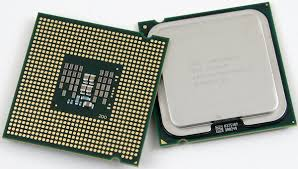CPU stands for Central Processing Unit and is found in most electronics, from computers and servers to smartphones and (smart) TVs. Usually, people refer to a CPU as a 'processor.' In a traditional computer, a processor looks like this (without a cooler):

The 'C' in 'Central' also hints at the central role a CPU plays: the CPU performs calculations and interprets 'instructions' when you browse the web, play games, edit a text document, or run other software.
CPUs contain billions of microscopic transistors (over 100 billion as of 2022). These transistors enable the processor to perform the calculations needed to execute programs. For these calculations, transistors are turned on or off, where ‘on’ represents a 1 and ‘off’ represents a 0.
What does a CPU do?
We mentioned that a CPU performs calculations and interprets instructions, but what does this mean? A CPU executes a three-step process:
- Fetch: The CPU retrieves an instruction (i.e., a calculation) from RAM (which, in turn, may read it from a drive).
- Decode: The CPU deciphers the instruction.
- Execute: The CPU executes the instruction.
The calculation/instruction can be a simple mathematical operation, execution of a function, comparison of numbers, or moving data in memory. Everything your computer does is expressed in numbers, so your CPU is essentially a fast calculator (this also applies to specialized hardware like your graphics card). A calculation can be part of starting your computer, playing a game, or any other action you perform on a computer.
Nowadays, a CPU also plays a managerial role by passing data to specialized hardware. For instance, the graphics card may instruct an SSD to move a file to RAM, or tell a graphics card to display a flash of light in a game.
CPU cores & threads
A CPU contains one (in the past) or more (since 2005) CPU cores. A CPU core can work on one task at a time (i.e., execute one calculation at a time). This is a physical limitation of the speed at which a CPU can execute tasks.
To address this limitation, the first commercial CPU with 'simultaneous multithreading' was introduced in 2002 (called Hyper-threading by Intel). This technique splits a CPU core into two 'virtual cores,' or CPU threads. A common analogy is that a CPU core is a mouth that eats, and the two threads are the hands that manage or prepare the 'workload.' CPU threads help a CPU core perform tasks faster but are not (necessarily) faster than two CPU cores without additional threads.
Thanks to advancements in processor technology, the first true dual-core processor with two CPU cores was introduced in 2005. Nowadays, CPUs can have dozens of cores, each with two virtual threads. In a multi-core CPU, each core acts as a separate CPU with two CPU threads. This allows the CPU to execute more than one task simultaneously, making it practically faster than a single-core processor.
Note, however, that not all applications require multiple CPU cores and therefore do not benefit equally from additional cores. Video editing, for example, benefits from more cores, whereas games benefit much less.
Intel, AMD & ARM
Many brands develop processors, but the biggest names in this field are Intel and AMD. Another major name is ARM, which primarily sells CPU designs but does not manufacture them. These CPU designs are then produced by many other companies for their own products, such as Apple and Samsung.
Intel and AMD are both known for the processors they develop. Over the years, there has been some fluctuation in which company produces the fastest, most energy-efficient, or cheapest processors at a given time. While some people prefer one manufacturer over the other, both Intel and AMD produce highly reliable and excellent processors, and the performance differences between the two have become much smaller.




